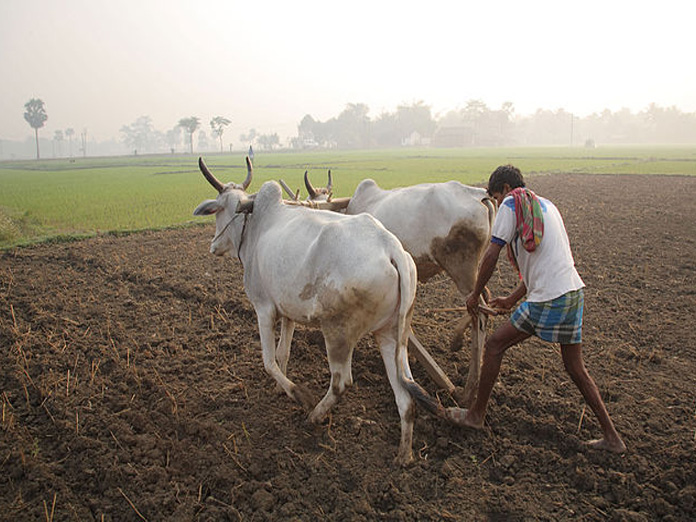Budget wish list for revival of rural and agricultural economy

The coming budget is going to be presented on the backdrop of severe agrarian and rural distress the rhetoric needs to be profarmer and prorural The rural economy has been stagnant and volatile for the last three years There are a number of farmers agitations across India due to lower prices for their harvest, lack procurement at minimum support price, demanding loan waivers, complaints abo
The coming budget is going to be presented on the backdrop of severe agrarian and rural distress; the rhetoric needs to be pro-farmer and pro-rural. The rural economy has been stagnant and volatile for the last three years. There are a number of farmer’s agitations across India due to lower prices for their harvest, lack procurement at minimum support price, demanding loan waivers, complaints about delay in crop insurance claims, lack of storage facilities and market infrastructure.
Given that the average farm size was too little for majority of small farmers, there may not be a significant increase in farmers’ incomes by enhancing crop productivity and profitability. The average agricultural household income was less than Rs 1,00,000 per annum in India.
Keeping the limitation of agricultural sector, there is a need for enhancing the income opportunities from the non-farm and off-farm sectors in rural areas. It is already evident that, non-farm income is higher than farm income for many agricultural households. Hence, budget should look beyond agricultural sector to increase farmer’s incomes. Further, the budget may look in to the following options to alleviate rural distress.
Targeted Basic Income Scheme
To ensure minimum basic income for every household, the Economic Survey 2016-17 suggested universal basic income for each household. But given fiscal constraints, universality may not be feasible in India. A few economists suggesting targeted basic income scheme, which may target the poorest of the poor (say about 30 per cent of rural population) to provide the basic income to meet the essential needs like food, cloth, shelter, education and health. But the identification of the poorest of the poor is a crucial thing to the success of this type of schemes to avoid leakages.
It is well known fact that, poorest of the poor are living in rural areas and mostly earn their livelihoods as small and marginal farmers, tenant farmers and agricultural labour. Targeting these groups of households under the scheme is not a difficult task as village panchayats and gram sabhas are having records of all these households and know each other to cross check.
If identification of beneficiaries is to be entrusted to gram panchayats/sabhas, leakages can be reduced. Thanks to Jan Dhan Yojana scheme, most of these households are already linked to Aadhaar seeded bank accounts. Direct money transfer of say Rs.10,000 per household in two installments during the starting of the sowing season in each year can help these targeted rural households in many ways.
The additional budget required to target 30 per cent of the poorest of the poor will be Rs.36,000 crore, which is manageable, in addition to the continuation of all the existing schemes. It provide working capital for agricultural operations, reduce dependence on the moneylenders for petty needs, also provide initial investment for small petty businesses like working capital for running tea shop, cycle repair shop etc. This increases rural entrepreneurship; increases rural demand and generate employment and income through multiplier effect.
Ongoing agricultural schemes
The ongoing flagship programmes like Rastriya Krishi Vikas Yojana(RKVY) to increase farmers’ incomes, Prime Minister Krishi Sinchayi Yojana( PMKSY) to increase area under irrigation, Prime Minister Fasal Bhima Yojana(PMFBY) to increase coverage of crop insurance and e-National Agricultural Markets (NAM) for increasing market efficiency are started to give visible results. There is a need give high priority with more fund allocation to sustain the tempo and to ultimately benefits to reach small and marginal farmers.
Employment guarantee, PDS and housing
The role of employment guarantee programme (MGNREGA) and Public Distribution System (PDS) is noteworthy in removing hunger. Some studies pointed out that if MGNREGA and PDS function well in the rural areas, they reduced poverty by 11 to 12 per cent. There is a need for increasing rural demand and consumption through putting money in the hands of consumers. The budget allocations for employment guarantee programme, PDS, rural infrastructure projects like construction of rural roads, rural housing should be given high priority.
Reduce input costs and ease of doing business in rural areas
In the recent past, cost of inputs like seed, fertilizer and pesticide increased, but the output prices decreased. As a result, many farmers are incurring huge losses. It is also true for the most of the small scale rural industries. The advantage of rural areas in keeping costs low needs to be sustained to retain economic activities in rural areas. Hence there is a need to focus on creating rural infrastructure and other support services to reduce cost of living as well as to do business in rural areas.
Situation of tenant farmers
Tenant farmers are not benefiting from many of the government schemes like subsidized seed, bank loan, crop insurance scheme and subsidies on drip etc. The distress among tenant farmers is higher than owner farmer. Tenants have to pay about 30% to 40% of the average sales value of production to landlords as rent. This is unbearable if the crop fails, as it happens once in every three years. There is a need for a clear policy to ensure that the tenant farmers benefit equally as that of owner-farmers from all government schemes.
Extra helping hand to farm and rural sector
Overall, this budget needs to give extra helping hand to the farmers, tenants, agricultural labourer, village artisans and rural workers to increase and stabilize their incomes, so that they may not be forced in to debt trap in the hands of moneylenders.
(A Amarender Reddy - The author is Principal Scientist (Agricultural Economics),ICAR-Centre Research Institute for Dryland Agriculture, Hyderabad)







